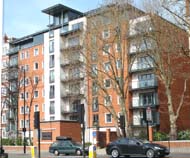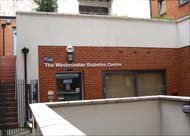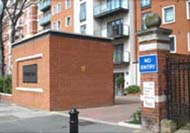Maida
Vale Hospital
for Nervous Diseases
for Nervous Diseases
4 Maida Vale, W9 1TL
Medical
dates:
Medical
character:
Specialist
The London Infirmary for
Epilepsy and Paralysis was founded by the German physician Julius
Althaus (1833-1900). It opened for out-patients only at 19
Charles Street (now renamed Blandford Place) in Marylebone.
The
following year a small number of in-patients were admitted.
In the 1872 the lease of the house expired and the Infirmary moved to Winterton House, a 3-storey building in Portland Terrace, on the north side of Regent's Park. The ground floor contained the Secretary's office, the Out-Patients Department and the dispensary. The wards were on the first floor, while the top floor contained accommodation for Matron and the staff. The following year the name of the Infirmary was changed, as it was considered too similar to the National Hospital for the Relief and Cure of the Paralysed and Epileptic in Queen Square. It became the Hospital for Diseases of the Nervous System but, in 1876, the name was changed again - to the Hospital for Epilepsy and Paralysis. From 1873 until 1903 it had only 20 beds - 8 for male patients, 8 for females and 4 for private patients.
In 1884 a 25-year-old man with jacksonian epilepsy was the first case to be successfully diagnosed and treated for a brain tumour. The tumour was surgically removed, but the patient died of meningitis a month later.
In 1890 an anonymous gift of £1200 enabled the Hospital to renew its lease for Winterton House for another ten years, but it was recognised that a new hospital building was urgently needed.
In 1900 a 99-year lease for a site at 2-4 Maida Vale was obtained from the Harrow Estate. Building work began and the first part of the Hospital for Epilepsy and Paralysis and Other Diseases of the Nervous System, Maida Vale, was completed in 1902 on the north side of the site. The building, formally opened in 1903 by Princess Louise, Duchess of Argyll, had an Out-Patients Department, a dispensary and offices, and ward accommodation for 38 beds (lack of funds prevented completion of the Hospital until 1913).
In 1908 a School of Massage and Electrotherapy was founded.
In 1910 discussion had taken place concerning amalgamation with the West End Hospital for Nervous Diseases, but nothing came of it. The lack of neuropathology laboratories and a radiology department were serious defects and would cause difficulties later; X-rays could only be obtained from private consulting rooms, which was expensive and inconvenient.
Princess Louise returned in August 1913 to open the now completed Hospital, which had cost a total of £35,000 (an anonymous donor had walked into the Board Room of the Hospital and handed the Secretary a £1000 note as a contribution to the building fund). At this time there were 70 beds. Most of the patients admitted suffered from chorea, tabes dorsalis (tertiary syphilis) and epilepsy.
During WW1 military and air force casualties with neurological injuries were treated at the Hospital. The Hospital offer of 50 beds for the use of the Royal Navy was accepted but never implemented. Instead, 35 beds of the Hospital became a section of the Third London General Hospital.
In 1917 the Hospital arranged with the Ministry of Pensions to create a Home of Recovery at Highfield in Golders Green for servicemen suffering from neurological injuries and war psychoneurosis. Later, neuological casualties from the Royal Flying Corps were also accepted. The Home closed soon after the war ended.
In the 1920s the Hospital pioneered the use of phenobarbiturates (Luminal) for the treatment of epilepsy - previously bromides had been used.
In 1937 the name of the Hospital was modified to The Maida Vale Hospital for Nervous Diseases (including Epilepsy and Paralysis). A new science was introduced to the investigation of nervous disease - electroencephalography - the study of brain physiology.
At the outbreak of WW2 the medical staff were depleted and no patients were admitted. Later, in December 1939, the first floor only was opened for in-patients. The surgical department moved to the Leavesden Hospital, a large mental hospital.
In October 1940 the Hospital suffered a direct hit from a high explosive bomb, but the small number of patients had been moved to the X-ray Department in the basement, and there were no casualties. The Out-Patients Department managed to keep functioning. Later more damage was caused by incendiary bombs.
The small X-ray department had been set up in the basement some years prevously to obtain skiagrams of the skull and the first neuroradiologist had been appointed in 1939, but it was not until after the war that a proper service could be established. A number of small single wards on the third floor used for the treatment of chorea patients were sacrificed and a new X-ray department installed. Radiological investigations, such as ventriculography, air encephalography and arteriography could then be carried out.
In the latter years of the war the King Edward's Fund had discussed the possibility of amalgamation of the three London neurological hospitals - the West End Hospital for Nervous Diseases, the National Hospital in Queen Square and the Maida Vale Hospital - and indeed the latter two did merge in 1947. Throughout its history, clinical staff at the Maida Vale had resigned and taken up contracts with the National Hospital, so it seemed fitting that the two Hospitals should become one. In 1948 they became a single postgraduate teaching hospital within the NHS.
A new pathology laboratory was built at the Maida Vale site, which became known as The National Hospital for Nervous Diseases, Maida Vale. In 1956 a new Out-Patients Department, a new X-ray Department and operating theatre, were officially opened by the Duchess of Gloucester. The third floor had been rebuilt, the bomb damaged wards had been repaired and new lifts installed. By this time the Hospital had 90 beds.
In 1974 it had 84 beds, but like many other NHS hospitals, the building had become run down and neglected. The Hospital closed in 1993 and the site sold.
Present status (April 2008)
The Hospital was demolished and the site redeveloped as a luxury apartment block. The Westminster Diabetes Centre is located at 4b, on the ground floor.
Winterton House, the second home of the Hospital, also no longer exists. The site now contains North Gate, an apartment block.
In the 1872 the lease of the house expired and the Infirmary moved to Winterton House, a 3-storey building in Portland Terrace, on the north side of Regent's Park. The ground floor contained the Secretary's office, the Out-Patients Department and the dispensary. The wards were on the first floor, while the top floor contained accommodation for Matron and the staff. The following year the name of the Infirmary was changed, as it was considered too similar to the National Hospital for the Relief and Cure of the Paralysed and Epileptic in Queen Square. It became the Hospital for Diseases of the Nervous System but, in 1876, the name was changed again - to the Hospital for Epilepsy and Paralysis. From 1873 until 1903 it had only 20 beds - 8 for male patients, 8 for females and 4 for private patients.
In 1884 a 25-year-old man with jacksonian epilepsy was the first case to be successfully diagnosed and treated for a brain tumour. The tumour was surgically removed, but the patient died of meningitis a month later.
In 1890 an anonymous gift of £1200 enabled the Hospital to renew its lease for Winterton House for another ten years, but it was recognised that a new hospital building was urgently needed.
In 1900 a 99-year lease for a site at 2-4 Maida Vale was obtained from the Harrow Estate. Building work began and the first part of the Hospital for Epilepsy and Paralysis and Other Diseases of the Nervous System, Maida Vale, was completed in 1902 on the north side of the site. The building, formally opened in 1903 by Princess Louise, Duchess of Argyll, had an Out-Patients Department, a dispensary and offices, and ward accommodation for 38 beds (lack of funds prevented completion of the Hospital until 1913).
In 1908 a School of Massage and Electrotherapy was founded.
In 1910 discussion had taken place concerning amalgamation with the West End Hospital for Nervous Diseases, but nothing came of it. The lack of neuropathology laboratories and a radiology department were serious defects and would cause difficulties later; X-rays could only be obtained from private consulting rooms, which was expensive and inconvenient.
Princess Louise returned in August 1913 to open the now completed Hospital, which had cost a total of £35,000 (an anonymous donor had walked into the Board Room of the Hospital and handed the Secretary a £1000 note as a contribution to the building fund). At this time there were 70 beds. Most of the patients admitted suffered from chorea, tabes dorsalis (tertiary syphilis) and epilepsy.
During WW1 military and air force casualties with neurological injuries were treated at the Hospital. The Hospital offer of 50 beds for the use of the Royal Navy was accepted but never implemented. Instead, 35 beds of the Hospital became a section of the Third London General Hospital.
In 1917 the Hospital arranged with the Ministry of Pensions to create a Home of Recovery at Highfield in Golders Green for servicemen suffering from neurological injuries and war psychoneurosis. Later, neuological casualties from the Royal Flying Corps were also accepted. The Home closed soon after the war ended.
In the 1920s the Hospital pioneered the use of phenobarbiturates (Luminal) for the treatment of epilepsy - previously bromides had been used.
In 1937 the name of the Hospital was modified to The Maida Vale Hospital for Nervous Diseases (including Epilepsy and Paralysis). A new science was introduced to the investigation of nervous disease - electroencephalography - the study of brain physiology.
At the outbreak of WW2 the medical staff were depleted and no patients were admitted. Later, in December 1939, the first floor only was opened for in-patients. The surgical department moved to the Leavesden Hospital, a large mental hospital.
In October 1940 the Hospital suffered a direct hit from a high explosive bomb, but the small number of patients had been moved to the X-ray Department in the basement, and there were no casualties. The Out-Patients Department managed to keep functioning. Later more damage was caused by incendiary bombs.
The small X-ray department had been set up in the basement some years prevously to obtain skiagrams of the skull and the first neuroradiologist had been appointed in 1939, but it was not until after the war that a proper service could be established. A number of small single wards on the third floor used for the treatment of chorea patients were sacrificed and a new X-ray department installed. Radiological investigations, such as ventriculography, air encephalography and arteriography could then be carried out.
In the latter years of the war the King Edward's Fund had discussed the possibility of amalgamation of the three London neurological hospitals - the West End Hospital for Nervous Diseases, the National Hospital in Queen Square and the Maida Vale Hospital - and indeed the latter two did merge in 1947. Throughout its history, clinical staff at the Maida Vale had resigned and taken up contracts with the National Hospital, so it seemed fitting that the two Hospitals should become one. In 1948 they became a single postgraduate teaching hospital within the NHS.
A new pathology laboratory was built at the Maida Vale site, which became known as The National Hospital for Nervous Diseases, Maida Vale. In 1956 a new Out-Patients Department, a new X-ray Department and operating theatre, were officially opened by the Duchess of Gloucester. The third floor had been rebuilt, the bomb damaged wards had been repaired and new lifts installed. By this time the Hospital had 90 beds.
In 1974 it had 84 beds, but like many other NHS hospitals, the building had become run down and neglected. The Hospital closed in 1993 and the site sold.
Present status (April 2008)
The Hospital was demolished and the site redeveloped as a luxury apartment block. The Westminster Diabetes Centre is located at 4b, on the ground floor.
Winterton House, the second home of the Hospital, also no longer exists. The site now contains North Gate, an apartment block.

The new apartment block looking across Maida Vale

The NHS still retains a foothold on the site with the Westminster Diabetes Clinic

Directions for the NHS Westminster Diabetes Clinic

Staff parking for the Westminster Primary Care Trust
(Author unstated) 1917 List of the various hospitals treating military cases in the United Kingdom. London, H.M.S.O.
Feiling A 1958 A History of the Maida Vale Hospital for Nervous Diseases. London, Butterworth.
Hibbert C, Weinreb B, Keay J, Keay J 2008 The London Encyclopedia, 3rd edn. London, Macmillan.
http://archives.ucl.ac.uk
www.queensquare.org.uk (1)
www.queensquare.org.uk (2)
Return to home page